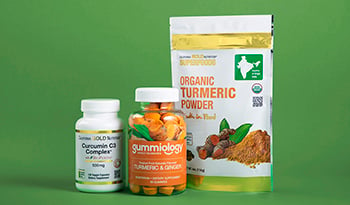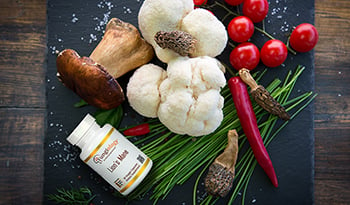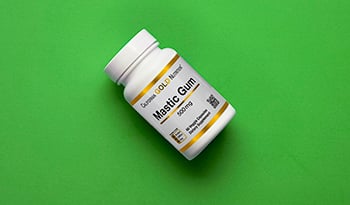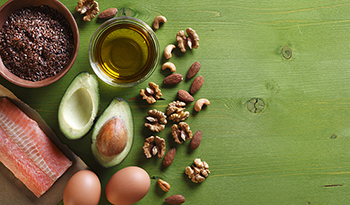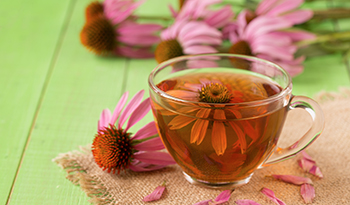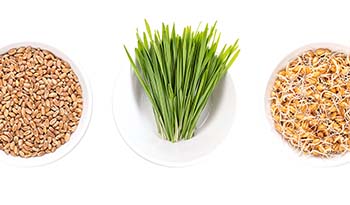Top 10 Ayurvedic Herbs and Their Health Benefits

Ayurvedic medicine is an ancient form of healing popular throughout Asia and India. Believed to be over 3,000 years old, ayurvedic medicine relies on a thorough understanding of the chakras, or energy centers of the body. The premise of Ayurvedic medicine is that true health occurs only when the mind, body, and spirit are in alignment. Ayurvedic medicine relies on using natural and holistic approaches to health and wellness, balancing diet and exercise with herbs.
The following are commonly used ayurvedic herbs.
Ashwagandha, Fatigue, and Stress
Ashwagandha is an adaptogenic herb that is reportedly helpful in managing chronic fatigue among other issues. Native to Asia, specifically India and regions of China, ashwagandha has been commonly used in ayurvedic medicine for thousands of years.
Studied Benefits of Ashwagandha Include:
- Anxiety and Stress: A 2014 study1 showed improvement in symptoms of anxiety and stress symptoms when taken.
- Energy and Endurance: Animal studies2 have also shown that ashwagandha can help improve energy levels and endurance. A 2015 study3 of athletes in Ayu showed that ashwagandha could help improve endurance and improve quality of life.
- Sexual Function: A 2015 study4 concluded that ashwagandha could improve sexual function in healthy women, specifically, increased libido.
Suggested dose: Ashwagandha - 500 mg once or twice per day.
Bitter Melon, Digestion, and Blood Sugar
This tropical plant, also known as bitter gourd, bitter melon, or (Momordica charantia), is commonly found in Asia (where it’s edible fruit is often consumed), Africa, and the Caribbean region. Bitter melon has been used since the days of antiquity for its health-promoting abilities.
Studied Benefits of Bitter Melon Include:
- Digestion - Bitter melon is frequently used in ayurvedic medicine to help soothe an upset stomach.
- Blood Sugar Levels - A 2009 animal study showed bitter melon could help reduce insulin resistance, which regularly occurs in those with diabetes. More recently, a 2015 study5 in Nutrition Journal showed the fruit’s ability to lower blood sugar levels when taken at doses of 2,000 and 4,000 mg per day.
- Cholesterol Levels - Studies6 show this fruit can help lower cholesterol levels.
Suggested dose: Bitter melon - As directed on the label.
Boswellia (Boswellia serrata) and Inflammation
Boswellia is an Ayurvedic herbal supplement that has been used for thousands of years to alleviate chronic health conditions.
Studied Benefits of Boswellia Include:
- Inflammation - Known for reducing inflammation in the body, bitter melon was used by ancient healers for bowel inflammation, ulcerative colitis, asthma, and arthritis-related joint pain.
- Asthma - A 2015 study7 showed that Boswellia could reduce inflammation in the lungs of asthmatics by reducing inflammation. This has the potential to help reduce breathing difficulties, which are routinely experienced by some with asthma.
- Arthritis - A 2019 randomized, double-blind placebo-controlled trial8 showed that Boswellia could reduce inflammation in those with arthritis, improve function, and reduce joint stiffness and pain. Further, researchers in a 2018 study9 also found that the combination of turmeric and Boswellia was even more effective in reducing arthritis pain, as it provides a synergistic effect.
Suggested dose: Boswellia - As directed on the label.
Bacopa and Cognitive Function
Traditionally used in ayurvedic medicine for its memory-enhancing benefits, Bacopa monnieri (Brahmi) has become more popular outside India over the last decade, due to studies showing its effectiveness.
Studied Benefits of Bacopa monnieri include:
- Memory and Cognition - A 2012 study10 in Evidence Based Complementary and Alternative Medicine concluded, “…Bacopa monnieri can improve attention, cognitive processing, and working memory….”. In addition, a 2014 meta-analysis study11 (a study that looked at several studies combined) concluded, “Bacopa monnieri has the potential to improve cognition, particularly speed of attention.” Similarly, in a 2016 study12, a “statistically significant improvement was seen in the tests relating to the cognitive functions with use of Bacopa monnieri.”
Suggested dose: Bacopa monnieri - As directed on the label.
Cardamom and Antioxidant Properties
A sweet Indian spice, often compared to mint, cardamom has been used in both the culinary arts and within traditional medicine for centuries.
Cardamom is believed by ayurvedic practitioners to have the following health properties:
- Antioxidant
- Anti-inflammatory
- Digestion aid
- Anti-microbial
- May help lower blood sugar
- May help reduce fatty liver13
- May help to lower cholesterol and prevent liver damage14
Cardamom - Available as a food spice, essential oil, or hot tea.
Gotu Kola and Brain Health
Gotu kola, also known as Centella Asiatica or Asiatic pennywort, is a green, leafy herbal vegetable commonly consumed throughout Asia. Related to carrots, parsley, and celery, this herb is rich in antioxidants, vitamin C, and B vitamins. It is used in traditional medicine for wounds and to help promote lactation.
Studied Benefits of Gotu Kola Include:
- Brain Health - According to a 2014 study15 in the Journal of Alzheimer’s Disease, caffeoylquinic acids, the main ingredient found in gotu kola, can help protect the brain against amyloid deposits, which are believed to cause Alzheimer’s disease. Additionally, a 2017 study16 in Neuroscience Letter also showed the active ingredient in gotu kola improved the nerves of the brain and helped preserve memory.
Suggested dose: Gotu kola - As directed on the label.
Licorice (DGL), Hormonal, and Digestive Health
When most think of licorice, candy — not an herb — comes to mind. However, licorice (deglycyrrhizinated licorice) is an herb that has played an important role in Traditional Chinese Medicine. In China, licorice is called gancao, which means “sweet grass.” Licorice’s use goes back to 2100 BC and was first described in Shennong׳s Classic of Materia Medica17.
It is frequently used for those with adrenal fatigue, a condition that many women experience. The active ingredients in licorice are glycyrrhizin and genistein among others. Studies have shown the benefit of DGL licorice for decades.
Licorice may have benefits for the following:
- Digestion - A 1968 study18 showed this natural medicine's ability to help heal stomach ulcers and intestinal ulcers. A 1978 study19 in the British Medical Journal reported that it may be of help in the prevention of stomach ulcers, as well. It can also relieve upset stomachs, according to a 2012 study20.
- Menopause - A 2013 study21 showed that licorice could help balance hormones in women who were having symptoms related to menopausal changes.
Suggested dosage: Licorice root - As directed on the label.
Neem’s Antibacterial Properties
Neem originates from the seeds, barks, and leaves of the neem tree. It is also known as Azadirachta indica and Indian lilac. Indigenous to India, this plant also grows in the southern parts of Persia.
Neem is believed to have the following benefits:
- Insect repellant
- Antioxidant
- Anti-inflammatory22
- Anti-bacterial
- Ant-viral23
- Digestive help
- Oral health improvement24 when used as a mouthwash or toothpaste
Suggested dosage: Neem - As directed on the label.
Triphala, Arthritis, and Diabetes
Triphala is an herbal superstar with a 1,000-year-plus history. A polyherbal medicine, it is a favorite among ayurvedic practitioners and consists of the following three herbs:
- Amla (Emblica officinalis) – Also known as Indian gooseberry
- Bibhitaki (Terminalia bellirica)
- Haritaki (Terminalia chebula)
Studied Benefits of Triphala Include the following:
- Arthritis - A 2017 study25 showed that haritaki could help reduce symptoms of joint arthritis, a common ailment associated with aging.
- Diabetes- The amla component of Triphala can help lower blood sugar, according to a 2014 study26. A more recent 2017 study27 concluded that the active ingredient in amla “…exerts anti-diabetic activity through the action on β-cells of the pancreas that stimulates insulin secretion and decreases glucose intolerance.”
- Gout – Gouty arthritis is a common ailment caused by uric acid crystals building up in the joints, leading to excruciating pain. Triphala may be able to help prevent this. A 2016 study28 showed that both bibhitaki and haritaki could lower uric acid levels in the blood. However, bibhitaki was more effective.
While Triphala is frequently used by some for constipation with success, I was unable to find any studies specifically on constipation. I did, however, find a study that shows the herb had a positive effect on the gut microbiome, which may explain why it has reportedly been helpful in the treatment of this common digestive issue.
Suggested dose: Triphala - As directed on the label.
Turmeric is a Potent Antioxidant
Turmeric, also known as Curcuma longa and Indian saffron, is a rooted plant in the ginger family, often consumed for its anti-inflammatory, antioxidant, and digestive health properties. Curcumin, a chemical found in turmeric, is believed to provide many of the health benefits.
While many people have used turmeric as a spice to enhance their food for over the past 4,000 years, turmeric has played an important role in medicine. Today, its use continues to be researched as an alternative treatment approach for many common sicknesses, injuries, and chronic diseases.
Studied Benefits of Turmeric Include the following:
- Arthritis - Turmeric may be helpful in reducing pain for both rheumatoid and osteoarthritis29. Scientists have discovered that turmeric can reduce inflammation similar to multiple widely used prescription drugs.
- Antioxidant boost - Turmeric is also a potent antioxidant, either when consumed as a spice or when taken as a curcumin supplement. Turmeric can help prevent oxidation, according to a 2016 report in the journal Diseases30.
- Memory - A 2017 study31 in the Journal of Alzheimer’s Disease concluded that turmeric could also play an important role in preventing memory loss. It may be an essential supplement for anyone wanting to optimize memory.
- Asthma - A 2010 study32 has demonstrated improved management of bronchial asthma with the use of turmeric when consumed with Boswellia serrata and licorice root. A 2014 study in the Journal of Clinical and Diagnostic Research33 also concluded that turmeric, when taken orally, could help improve lung function in those with asthma.
Other conditions that turmeric may help with, according to studies, include:
- Diabetes
- High blood pressure
- Indigestion
- Gallstones34
- Bacterial infections
- Ulcerative colitis (colon inflammation)
- Helps remove toxins like mercury from the body35
Suggested Dose: Many people consume turmeric by drinking it in tea form, using it as a powder for some skin conditions, and also swallowing it in capsule form. Curcumin/turmeric supplements are usually taken at doses of 500 mg daily or 500 mg, up to three times per day.
References:
- Pratte MA, Nanavati KB, Young V, Morley CP. An Alternative Treatment for Anxiety: A Systematic Review of Human Trial Results Reported for the Ayurvedic Herb Ashwagandha (Withania somnifera). Journal of Alternative and Complementary Medicine. 2014;20(12):901-908. doi:10.1089/acm.2014.0177.
- J Med Food. 2002 Winter;5(4):211-20. Ashwagandha improves endurance in animal studies.
- Choudhary B, Shetty A, Langade DG. Efficacy of Ashwagandha (Withania somnifera [L.] Dunal) in improving cardiorespiratory endurance in healthy athletic adults. Ayu. 2015;36(1):63-68. doi:10.4103/0974-8520.169002.
- Dongre S, Langade D, Bhattacharyya S. Efficacy and Safety of Ashwagandha (Withania somnifera) Root Extract in Improving Sexual Function in Women: A Pilot Study. BioMed Research International. 2015;2015:284154. doi:10.1155/2015/284154.
- Inayat U Rahman, Khan RU, Khalil Ur Rahman, Bashir M. Lower hypoglycemic but higher antiatherogenic effects of bitter melon than glibenclamide in type 2 diabetic patients. Nutr J. 2015;14:13. Published 2015 Jan 26. doi:10.1186/1475-2891-14-13
- Pakistan Journal of Pharmaceutical Sciences . Sep2016, Vol. 29 Issue 5, p1565-1570
- International Journal of Clinical Experimental Pathology. 2015; 8(1): 236–243.
- Phytotherapy Research 2019 May;33(5):1457-1468. doi: 10.1002/ptr.6338.
- Bannuru RR, Osani MC, Al-Eid F, Wang C. Efficacy of curcumin and Boswellia for knee osteoarthritis: Systematic review and meta-analysis. Semin Arthritis Rheum. 2018;48(3):416-429. doi:10.1016/j.semarthrit.2018.03.001
- Peth-Nui T, Wattanathorn J, Muchimapura S, et al. Effects of 12-Week Bacopa monnieri Consumption on Attention, Cognitive Processing, Working Memory, and Functions of Both Cholinergic an Monoaminergic Systems in Healthy Elderly Volunteers. Evidence-based Complementary and Alternative Medicine : eCAM. 2012;2012:606424.
- Journal of Ethnopharmacol. 2014;151(1):528-35. doi: 10.1016/j.jep.2013.11.008. Epub 2013 Nov 16.
- Kumar N, Abichandani LG, Thawani V, Gharpure KJ, Naidu MUR, Venkat Ramana G. Efficacy of Standardized Extract of Bacopa monnieri (Bacognize®) on Cognitive Functions of Medical Students: A Six-Week, Randomized Placebo-Controlled Trial. Evidence-based Complementary and Alternative Medicine : eCAM. 2016;2016:4103423.
- BMC Complement Altern Med. 2019; 19: 59. Published online 2019 Mar 12. doi: 10.1186/s12906-019-2465-0
- Lipids Health Dis. 2017; 16: 151.Published online 2017 Aug 14. doi: 10.1186/s12944-017-0539-x
- Herb of Elightenment , accessed March 31, 2018 http://herbscoop.com/herbs-for-health/amazing-benefits-gotu-kola-enlightenment-herb/
- Gray, N. E., Morré, J., Kelley, J., Maier, C. S., Stevens, J. F., Quinn, J. F., & Soumyanath, A. (2014). Caffeoylquinic acids in Centella asiatica protect against β-amyloid toxicity. Journal of Alzheimer’s Disease : JAD, 40(2), 359–373. http://doi.org/10.3233/JAD-131913
- Neuroscience Letter. 2017 Apr 12;646:24-29. doi: 10.1016/j.neulet.2017.02.072. Epub 2017 Mar 6.
- Wang L, Yang R, Yuan B, Liu Y, Liu C. The antiviral and antimicrobial activities of licorice, a widely-used Chinese herb. Acta Pharmaceutica Sinica B. 2015;5(4):310-315. doi:10.1016/j.apsb.2015.05.005.
- Hajirahimkhan A, Simmler C, Yuan Y, et al. Evaluation of Estrogenic Activity of Licorice Species in Comparison with Hops Used in Botanicals for Menopausal Symptoms. Ahmad A, ed. PLoS ONE. 2013;8(7):e67947. doi:10.1371/journal.pone.0067947.
- Tewari SN, Trembalowicz FC. Some experience with deglycyrrhizinated liquorice in the treatment of gastric and duodenal ulcers with special reference to its spasmolytic effect. Gut. 1968;9(1):48-51.
- Hollanders D, Green G, Woolf IL, et al. Prophylaxis with deglycyrrhizinised liquorice in patients with healed gastric ulcer. British Medical Journal. 1978;1(6106):148.
- Raveendra KR, Jayachandra, Srinivasa V, et al. An Extract of Glycyrrhiza glabra (GutGard) Alleviates Symptoms of Functional Dyspepsia: A Randomized, Double-Blind, Placebo-Controlled Study. Evidence-based Complementary and Alternative Medicine : eCAM. 2012;2012:216970. doi:10.1155/2012/216970.
- Mosaddek A. S. M., Rashid M. M. U. A comparative study of the anti-inflammatory effect of aqueous extract of neem leaf and dexamethasone. Bangladesh Journal of Pharmacology. 2008;3(1):44–47. doi:10.3329/bjp.v3i1.836
- In vitro' antiviral activity of neem (Azadirachta indica. A. Juss) leaf extract against group B coxsackieviruses. Badam L, Joshi SP, Bedekar SS J Commun Dis. 1999 Jun; 31(2):79-90.
- To evaluate the antigingivitis and antipalque effect of an Azadirachta indica (neem) mouthrinse on plaque induced gingivitis: A double-blind, randomized, controlled trial.bChatterjee A, Saluja M, Singh N, Kandwal AbJ Indian Soc Periodontol. 2011 Oct; 15(4):398-401.
- Accessed August 7, 2020 https://pubmed.ncbi.nlm.nih.gov/28969626/
- D'souza JJ, D'souza PP, Fazal F, Kumar A, Bhat HP, Baliga MS. Anti-diabetic effects of the Indian indigenous fruit Emblica officinalis Gaertn: active constituents and modes of action. Food Funct. 2014;5(4):635-644. doi:10.1039/c3fo60366k
- Fatima N, Hafizur RM, Hameed A, Ahmed S, Nisar M, Kabir N. Ellagic acid in Emblica officinalis exerts anti-diabetic activity through the action on β-cells of pancreas. Eur J Nutr. 2017;56(2):591-601. doi:10.1007/s00394-015-1103-y
- Usharani P, Nutalapati C, Pokuri VK, Kumar CU, Taduri G. A randomized, double-blind, placebo-, and positive-controlled clinical pilot study to evaluate the efficacy and tolerability of standardized aqueous extracts of Terminalia chebula and Terminalia bellerica in subjects with hyperuricemia. Clin Pharmacol. 2016;8:51-59. Published 2016 Jun 22. doi:10.2147/CPAA.S100521
- Rachel Groff, Meghan Strom, Laura Hopkins, Lena Feng, Allison Hopkins and Janet Funk. Dietary Supplements and Nutritional Approaches Used for Rheumatoid Arthritis Self-Management April 2017. The FASEB Journal vol. 31 no. 1 Supplement lb396
- Griffiths K, Aggarwal BB, Singh RB, Buttar HS, Wilson D, De Meester F. Food Antioxidants and Their Anti-Inflammatory Properties: A Potential Role in Cardiovascular Diseases and Cancer Prevention. Battino M, ed. Diseases. 2016;4(3):28. doi:10.3390/diseases4030028.
- J Alzheimers Dis. 2017;60(2):451-460. doi: 10.3233/JAD-170354.
- Houssen ME, Ragab A, Mesbah A, El-Samanoudy AZ, Othman G, Moustafa AF, Badria FA. Natural anti-inflammatory products and leukotriene inhibitors as complementary therapy for bronchial asthma. Clin Biochem. 2010 Jul;43(10-11):887-90.
- Abidi A, Gupta S, Agarwal M, Bhalla HL, Saluja M. Evaluation of Efficacy of Curcumin as an Add-on therapy in Patients of Bronchial Asthma. Journal of Clinical and Diagnostic Research : JCDR. 2014;8(8):HC19-HC24. doi:10.7860/JCDR/2014/9273.4705.
- Li Y, Li M, Wu S, Tian Y. Combination of curcumin and piperine prevents formation of gallstones in C57BL6 mice fed on lithogenic diet: whether NPC1L1/SREBP2 participates in this process? Lipids in Health and Disease. 2015;14:100. doi:10.1186/s12944-015-0106-2.
- J Appl Toxicol. 2010 Jul;30(5):457-68. doi: 10.1002/jat.1517.
DISCLAIMER:This Wellness Hub does not intend to provide diagnosis...














































































 Table of Contents
Table of Contents



